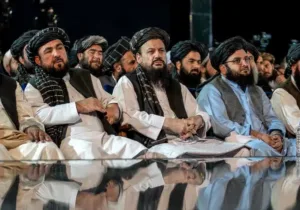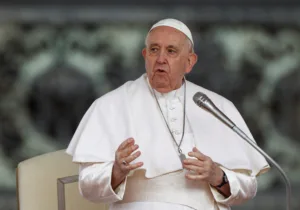I appreciate Michael McKoy’s recent “What Does Pacifism Have to Say About Ukraine?” But I remain unimpressed by the pacifist view. Michael will, I think, recover from this blow. In any case, he makes several points that I would like to comment on.
To begin, McKoy argues that his pacifism is rooted both in Christian conviction and political science. Since its founding, Providence has written both directly and indirectly against the Christian case for pacifism, including a snarky but sincere piece of my own. Indeed, picking a fight with pacifism—and offering a robust Christian argument against it—is one of the reasons for our very existence. Rather than rehash at length the arguments we’ve already made, I’ll simply defer to what we have on record, save to note one thing. My primary argument against the pacifist prescription is that it is very often—most often?—impotent against the bullies, brutes, and the harsh realities of our world, and because it is so, it violates the Christian norm of charity. It fails to promote the flourishing of victim, rescuer, and victimizer.
Regarding McKoy’s support of pacifism as a view rooted in political science, I have a few things to say. First, Mckoy gestures to the bargaining model of war, a central tool in international relations theory to offer a rational explanation for why wars start. The basic assumption behind the bargaining model is that war is an aberration. War puzzles political theorists who decry the irrationality of failing to avoid something so devastating and wasteful. The only explanation, the model suggests, is that one or more of the conflicting actors have failed to properly weigh the other’s capabilities—or to overstate their own—or that they miscalculated their adversary’s willingness to fight. If the adversaries properly understood all these things, the theory goes, they would confirm, in McKoy’s phrasing, that “there always exists a pre-war settlement that is more materially advantageous to all sides than any outcome following war.” The goal of crisis bargaining, then, is to figure out the bargaining range—the division of the pie that all parties prefer to fighting.
Such a view reduces a great many complexities in rather simplistic order. What I’ll say here is only that “material advantage” is not always—if ever—the only reason adversaries might fight. Indeed, the bargaining model acknowledges that there are typically certain things at stake that are indivisible—that is, that cannot be shared, negotiated away, or abandoned. This is to say—as the just war tradition says—that there are moral reasons, not simply material, that sometimes compel us to fight. Another way of putting this is that there are some pies we will never permit to be carved up. Come to my home looking to carry away my children, and there is nothing to negotiate. In Ukraine, one of the values at stake is Ukrainian sovereignty—Russia wants it, and Ukraine would much prefer to keep it. Figuring out who has the power to get what they want on this point pretty much sums up the reason they are fighting.
McKoy makes a good point when he stresses that the work of pacifism begins before the bullets start flying. He’s right to lament the West’s role in helping Putin miscalculate regarding Ukraine’s—extraordinary—capacity to fight. We gave Putin every reason to think that the West would not rally to the degree that it has to help Ukraine. But McKoy says too much when he appears to suggest that had the West signaled its willingness to support Ukrainian neutrality that the war could have been avoided. He’s not the first to suggest this; it’s been a staple declaration of some realists throughout this fight. But it’s whimsy, not realism, to imagine that neutrality would have appeased Putin. The Russian kleptocrat has never accepted the loss of the former Soviet satellites and republics. A cursory look at Ukraine’s history since the iron curtain fell proves the enduring character of Putin’s regime has been his continual efforts to undermine the country’s independence and to keep her within the grip of the Russian sphere of influence. The Orange Revolution of 2004 signaled Putin’s first failure. Ten years later, he doubled down on his effort by taking advantage of political unrest within Ukraine by invading Crimea, supporting insurrection in eastern Ukraine, and then overtly invading when the rebels were facing defeat. At the time, Ukraine’s constitution bound her to the principle of non-coalition and future neutrality, in accordance with Ukraine’s “Declaration of State Sovereignty,” which pledge the country to becoming “permanently neutral state.” Such legislative commitment did not deter Putin.
While NATO’s expansion and European Union talks with Ukraine caused Putin consternation, there is no credible argument that NATO expansion was an aggression toward Putin and Russia. It has always only been a defensive alliance. The only threat it posed to Putin was to his own aggressive ambitions. To be sure, the just war commitment to war as a last resort can rightly critique the West’s statements and actions in the pre-war situation. But this critique cannot credibly extend to suggest that Putin could have been appeased or that either the 2014 or 2022 invasion of Ukraine could have been averted by anything short of Ukraine moving into the Russian sphere of influence. Neutrality was never enough.
My last quibble is with McKoy’s assertion that “pacifism argues that the only means of breaking the cycles of violence is to recognize the short-term and long-term devastation of war, examine the decisions and dynamics that perpetuate these cycles, and make the tough decisions necessary to reject violence and ensure peace.” This is a particularly curious thing to say in that it is clearly empirically untrue. The just war tradition, too, gives priority to “assurances, compromise, and de-escalation” when these tools are morally appropriate, sufficiently efficacious in protecting the innocent, righting injustice, or punishing evil. But the just war tradition also is committed to the reasoned belief that because our enemy always carries a veto to our peaceful ambitions, wars must sometimes be fought.
In the middle of the twentieth century, cycles of Japanese aggression in the Pacific were ended not by rejecting violence or envisioning peace, but by applying greater force against Japanese militarism than it was capable of absorbing. Once the bullets started flying—once the Japanese were already committed to violence—Allied might—taking the form of breaking things and killing people—was, by God’s grace, the only thing that ended the War in the Pacific. Only when our enemies in the Pacific were pacified were they convinced to abandon violence. Much followed, including benevolent post bellum Allied treatment and the establishment of order, justice, and, ultimately, conciliation. The relationship now enjoyed between America and Japan gives testimony to the capacity of just war to be the first step in the path toward peacemaking.
This is to say that peace, for some, is an acquired taste. So sometimes the fight must be put to the enemy to put him in the mood for doing so.






